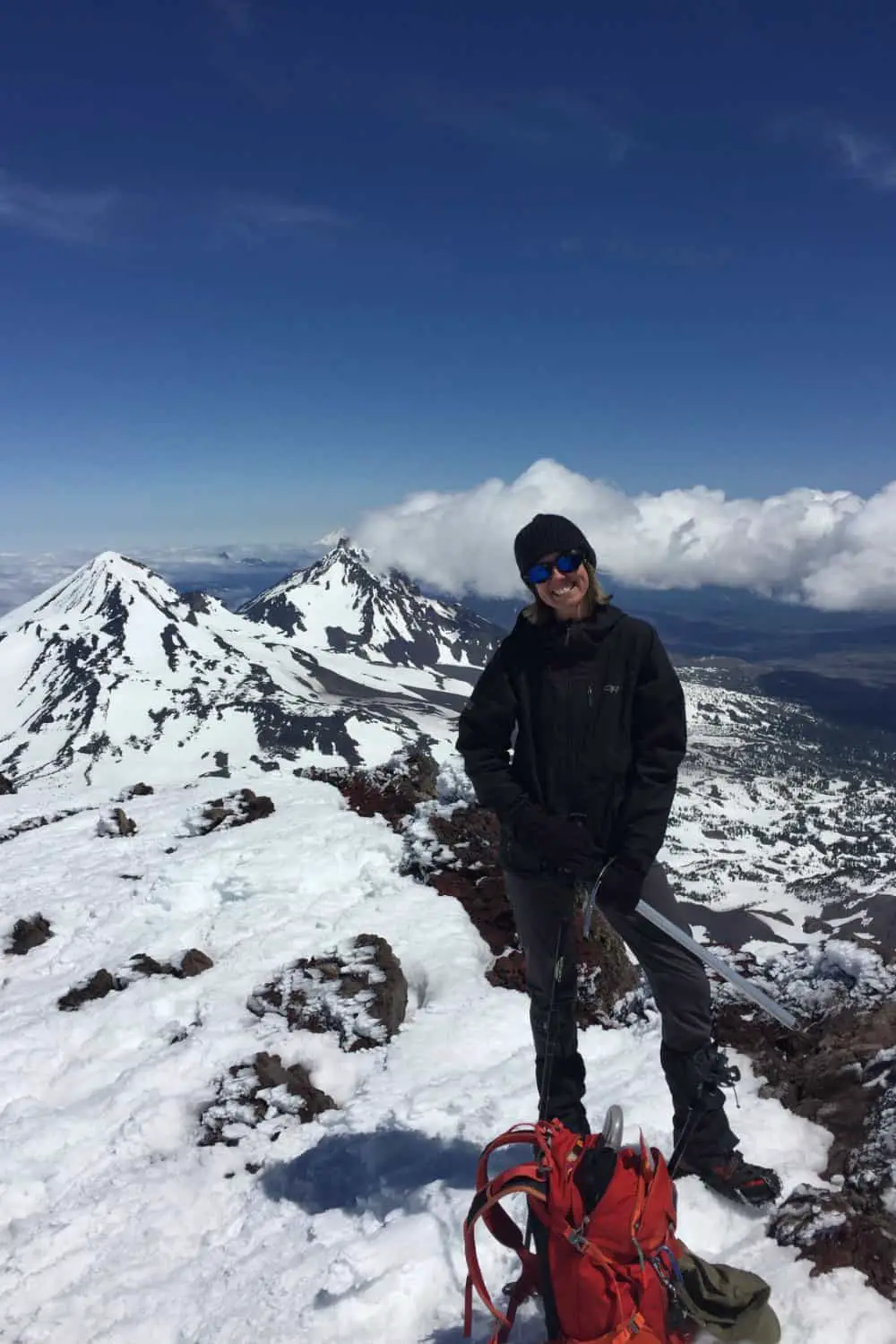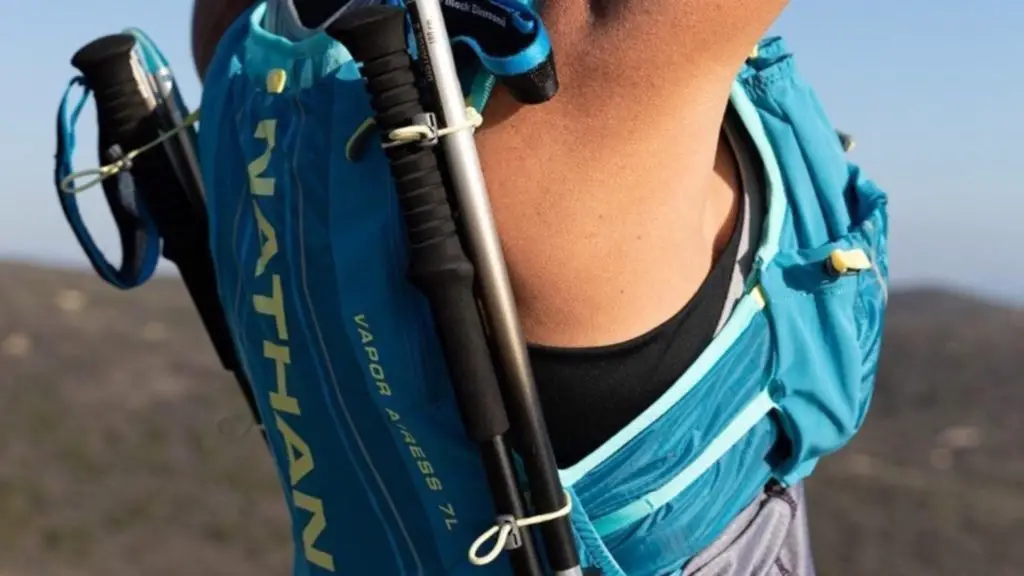For short trots, local/urban adventures, or ultralight hikers that are experienced in the wilderness and have pared their backpack down to bare-bones minimum, a hydration pack or vest might be the way to go. Both options will allow you to carry a couple liters of water and your small essentials, and some even have a pocket roomy enough to stuff an extra layer into.
Camelbak and Nathan are the industry leaders in this category, but Ultimate Direction, Osprey, and Solomon have all introduced some nice vests and packs to the market over the last couple years.
The purpose of a hydration pack is to carry water in a puncture-proof, lightweight container, minimizing your pack weight and making drinking so convenient that you can’t help but stay evenly hydrated throughout your hike. Most packs have a way of attaching the drinking tube to your sternum strap, a magnet or a little loop; sometimes I just shove mine under a strap. But you wind up with liters of water just inches from your mouth at all times by adding just a few ounces to your pack. The incredibly easy access to your drinking water makes this system a real asset to your safety on the trail, especially on super hot days or for those folks who find mini-breaks to get water bottles out of their packs a nuisance.
Choosing a Hydration Pack/Vest
- Types of hydration packs: Find a pack that’s designed for the activities you do
- Capacity: Be sure the pack has enough space for your water and gear
- Fit: Make sure the pack fits your torso length and hip size
- Features: Consider additional features, like bite valve on/off switches and quick-disconnect tubing
Hydration vests and hydration packs are similar in form and function and there is a wide range of design/fit: on one end of the spectrum you have very obvious vest-shaped vests with wide shoulders and lots of pockets; on the other you have packs made mostly of thin straps and a pack that is essentially just a reservoir holder. In the middle you get hybrid vest-packs with slightly wider straps that have pockets on them. More about each:
Hydration Vests
Hydration vests look like vests, often cropped to about mid-rib length, with a focus on being lightweight with easy access to your essentials. Vests were originally designed for runners, a pack with minimal bounce, but they have become popular with hikers and fastpackers. With multiple pockets for hydration flasks, gels, gloves, headlamp, and often designated zipper pockets for phone and keys, these little guys pack quite a punch for their size. Many feature a pocket for a light jacket and loops for poles or an axe. The evenly-distributed weight and lack of flopping while moving fast are easy on the torso.
Some favorite vests tailored specifically for women (L refers to storage capacity not bladder capacity):
- Nathan VaporHowe 4L 2.0 Women’s Race Vest
- Nathan VaporAiress 7L 2.0
- Ultimate Direction Women’s Ultra Vesta 5.0
- Ultimate Direction Women’s FastpackHer 20
- Osprey Dyna 6L 1.5
- Salomon S/Lab Sense Ultra 5 Set
- Salomon Women’s Advanced Skin 8 W Set Pack
- Camelbak Women’s Circuit Hydration Vest 5L
- REI Swiftland Hydro Running 5L
Hydration Packs
Hydration packs tend to be shaped more like tiny backpacks and work better for folks who want less coverage and a slim profile. They’re better for walking-paced hiking vs. trail running because of the flop factor: most are only secured by thin-yet-padded shoulder straps and a single sternum strap, but if you tend to sweat a lot or just don’t like the feel of the vest, you’ll like the pack option.
Most feature at least a couple zippered pockets and a couple open shove-it pockets for your bare minimums (I love my tiny 2.5L Camelbak, but if I need to carry anything more than its 1.5L water reservoir, a few gel packets, phone, keys, headlamp, and gloves, I have to resort to pockets or a bigger pack, though I have been known to tie jackets and shirts to the outside of it, usually in the fall when I’m in Cold Weather Layers Denial).
Hydration Packs tend to range in size from 5-10 liters of storage with a 1-3 liter hydration reservoir, and some of the larger/more complex hydration packs have rain flaps, loops for poles and axe, and often a good size pocket for extra layers.
Some favorite hydration packs tailored specifically for women (L refers to liters of pack/storage capacity, not bladder capacity):
- Osprey Raven 14L
- Osprey Salida 8L
- Osprey Kitsuma 1.5L
- Camelbak Charm 1.5L
- Gregory Women’s Avos 15L
- Gregory Women’s Amasa 10L
- Platypus Women’s B Line XC 8L
- Patagonia Women’s 9 Trails 18L
- REI Trail Hydro Women’s 20L
My Favorite Hydration Pack
Yep, you guessed it: that tiny 2.5 I mentioned. I have a couple others, but this fits my body, my needs, my bare minimum approach to nice weather semi-populated trail runs. During the summer it’s not unusual for me to tie my shoes on my front porch and take off for Tiger Mountain from there; the trailhead is just a few minutes on foot. On those days I know that I really just need water, my phone, and maybe a small handful of snacks but I throw in a headlamp, gloves, and one long sleeved top just in case. In that case, a backpack would be overkill but pockets wouldn’t be enough. But a hydration pack is just right.
So the Camelbak is basically just a water holder. Sure it has straps and a couple pockets but ultimately this isn’t a backpack as much as it is just what the name implies: a hump on your back filled with water whose sole purpose is to keep you hydrated. So why do I like this one?
FIT: One main thing I like about it is simply its fit: it moves with me, and doesn’t feel constricting the way a hydration vest can. Sometimes the sway and flop can be a little distracting but the pack always feels secure and I enjoy the movement, especially on very hot days when I can catch a breeze between it and my back. It might sound loosey-goosey but it feels more dynamic to me, free.
STORAGE: I like its three little pockets (two zip, one is more like a pouch) perfect for keys, ID, phone, gloves, headlamp, a few Gu packets and a bar or other smallish snack. There’s also room in the big pocket where the bladder goes for a map, extra socks, or, if you have less than 2.5 liters to start you can roll up a shirt and stuff it in there. I’ve also clipped spikes, poles, a helmet, and jackets to the outside of mine. Not ideal but in a pinch worked just fine and the extra weight wasn’t any less comfortable as far as straps were concerned.
THE TUBE: Last but most importantly — it’s all about the drinking tube. To be able to drink while moving and not spill water all over myself was a tremendous turning point in my hiking career. Not having to stop, ever, improved my flow: I wasn’t having to go in and out of The Zone, get that mental momentum back, no — I could let my mind wander and focus on my breathing, my legs, my foot placement, my surroundings. That way that we get lost out there, mentally speaking. How we stop worrying about all the minutae of the day and just drift through the forest or up a ridge or along a river. Not having to interrupt that reverie for a drink of water is priceless.

Wendy Harrington is a California native who has lived in a small town at the foothills of the Cascade Mountains in Washington state since 2001. Her love of trail running and peakbagging has led her to summit all five Washington volcanoes, climb to the high points of three states, and put nearly a thousand miles a year on her boots. Her loves include ridgelines, saddles, granite, one-day pushes on big mountains, anything volcanic, long solo days, and objectives that push limits and test endurance.

